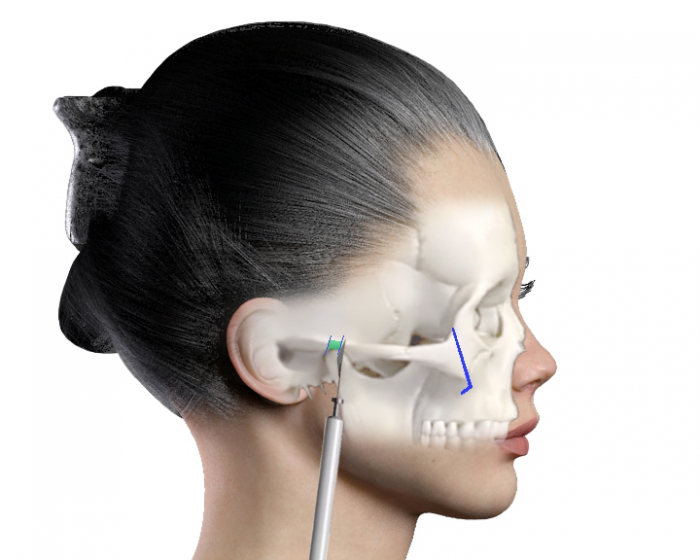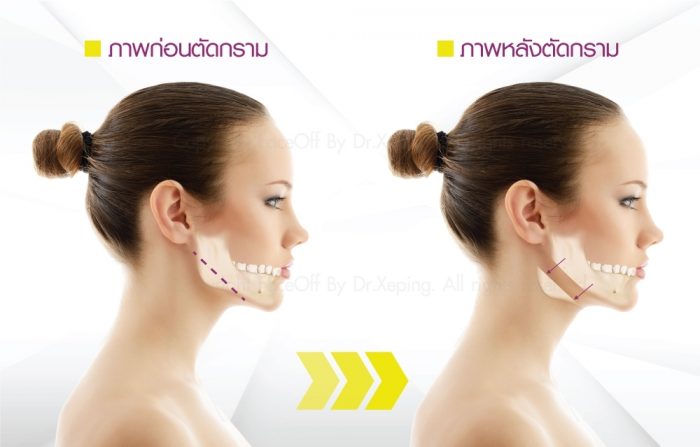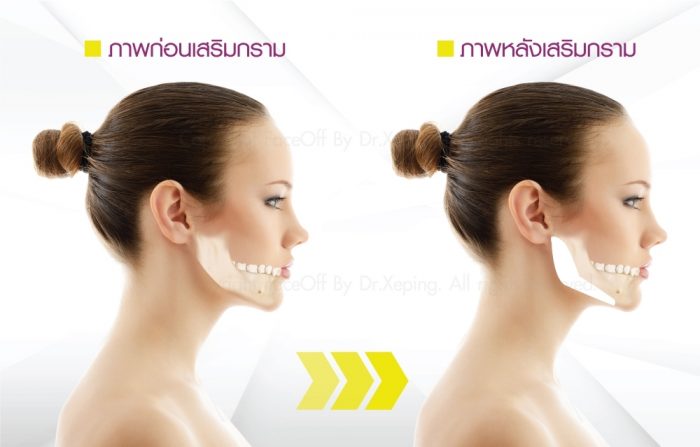ศัลยกรรมโหนกแก้ม/ผ่าตัดกราม
Cheekbone Surgery / Jaw Surgery
Cheekbone Surgery
Currently, there are several types of materials with various shapes for cheekbone surgery. Materials that are preferred for medical purposes for long period with high safety are:
- Silicone
- Gore-tex (e-PTFE)
- Medpore
- Alloderm
Some physicians prefer injecting filler or fat in lieu of alien materials.

Cheekbone surgery is leveling cheekbone for persons with low and narrow cheekbone for gaining balance and gentler look. The physician will make a wound inside the mouth above the lip or under the lower eyelash. Reconstructed silicone will be placed on former cheekbone and such wound will be stitched with chromic catgut. The duration of this surgery is around 1-2 hours with anesthesia or anesthetic injection.
Post-Operative Care
- The patient has to sleep in fowler’s position and do cold compression for stopping bleeding and relieving swelling.
- The patient has to eat mild food.
- If the wound is made inside the mouth, the patient is required to use mouthwashes frequently during the first week for cleaning. If the wound is made under the lower eyelash, the patient must frequently clean such wound.
- The patient will be appointed to meet the surgeon within 1 month after surgery.
Cheekbone Reduction
Cheekbone is the important structure of face that is considered as another position identifying characteristics of males and females, i.e., males often have high and clear cheekbone with less cheek fat. Cheekbone grinding may not reduce cheekbone’s height for too high cheekbone while cheekbone reduction surgery can help. To operate this surgery, the surgeon will make a wound inside the mouth and in the front area of ear before stitching with chromic catgut for the wound inside the mouth and normal sutures that will be stitched off in 5 days after surgery.

Operative Duration: Around 3-4 hours with anesthesia and the patient is also required to admit the hospital for 1 night with 1 week of recovery.
Jaw Surgery
Persons with wide faces caused by too large jawbones often have faces with improper proportion. Some of them demand slim faces therefore jaw surgery can make lower part of their faces to be slimmer with better proportion. Before operating surgery, jawbones and teeth are firstly x-rayed for planning surgery. The duration of this surgery is 2-3 hours with anesthesia and the patient is also required to admit the hospital for 1 night with 2-3 weeks of recovery.
There are 2 incision sites of jaw surgery:
- Extraoral Incision
The incision will be opened on external jaw corners with the approximate length of 3-5 centimeters. The surgeon will cut through muscles to the corner of the lower jawbones. Subsequently, muscles coating lower jawbones will be ripped out with demanded length. Jawbones are removed by using a bonesaw with the width as planned. After removing jawbones, the surgeon will grind the remaining bones to be smooth and stitch such incision with chromic catgut.
Disadvantages of Extraoral Incision: It may attack nerves of muscles around mouth’s corner causing dropped lip.
- Intraoral Incision
The size of this kind of incision is around 3-5 centimeters located behind the innermost molar. Muscles coating jawbones will be ripped out. Lower jawbones are removed by using a bonesaw. After removing jawbones, the surgeon will grind the remaining bones to be smooth and stitch such incision with chromic catgut.
Jaw surgery or lower jaw surgery is considered as a kind of surgery requiring expertise and experience of plastic surgeon in order to obtain the good outcome of surgery, i.e., balanced and beautiful jaws of both sides of the face.
Advantages of Intraoral Incision: It helps to reduce effects against nerves of muscles around mouth’s corner.

Jaw Reduction
In order to reduce jaw with slightly large size, jaw reduction is recommended in order to reduce thickness of jawbone around 2-3 millimeters. The incision will be opened like jaw surgery but a bonesaw is replaced by bone grinder. The duration of jaw reduction is2-3 hours with anesthesia and the patient is also required to admit the hospital for 1 night with 2-3 weeks of recovery.

Jaw Augmentation
It can be performed by adjusting lower part of the face for balancing and correcting unbalanced face shape due to unequal sizes of both sides of jawbones. Jaw augmentation will help to balance lower part of both sides of the face and stress jaw lines for improving male charming. Its incision is classified as extraoral incision located near external corner of jawbone with the approximate length of 3-5 centimeters. It is cut through muscles to jawbone and unwanted part of jawbone is removed by using a bonesaw before grinding and stitching. The disadvantage of this surgery is possibility of attack against nerves of muscles around mouth’s corner causing dropped lip.
Suggestions on Post-Operative Care
- The patient has to sleep in fowler’s position for 3-4 days in order to relieve swelling.
- The patient has to wash his/her mouth with clean water frequently in order to remove blood stains.
- The patient is required to use mouthwashes frequently in order to reduce the risk of infection.
- The patient has to eat mild food for 1-2 weeks.
- There may be some bruises on neck and under chin for 1 week that may be gone naturally. The patient may feel numb on his/her lips or encounter with twitching lip for 3 weeks but they will be gone naturally.
Orthogenetic Surgery
Orthogenetic Surgery is a kind of surgery helping to relocate jaws, improve and correct facial structure, as well as solving the problem on malocclusion. Since some minor abnormalities of size, shape, or location of jawbones may cause malocclusion and abnormality of facial shape.
